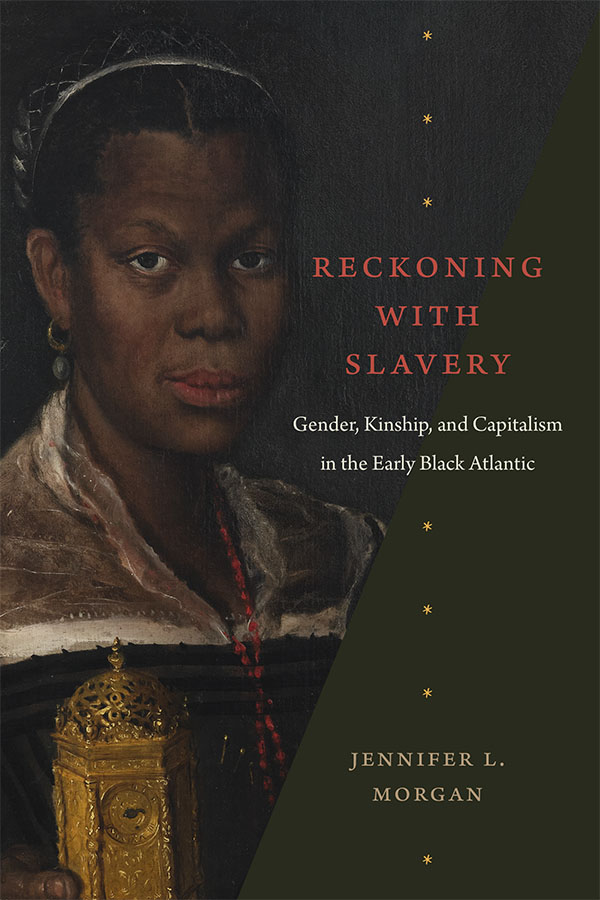The Book
Reckoning with Slavery: Gender, Kinship, and Capitalism in the Early Black Atlantic
The Author(s)
Jennifer L. Morgan

In this trenchant, erudite, and wide-ranging analysis, Jennifer Morgan argues that, from the start of the trans-Atlantic slave trade, enslaved African women were at the center of the emerging system of slavery—and that the system of slavery in the Americas was central to the development of modern capitalism. The prevalence of women, their erasure in the archival record, and the denial of their kinship ties (especially to parents and children) at the heart of enslavement are central, Morgan argues, to understanding the ideological workings of the emerging system of Atlantic slavery. And this system of slavery was important in Europe and the Americas not just because it extracted and concentrated wealth but also because the ideological innovations and requirements of the slave system, as early the seventeenth century, helped generate the modern domains of mathematics, accounting, demography, and political economy that have so profoundly shaped the modern world.
Morgan frames the book as a series of thematic chapters, grounded largely in the writings of Euro-American enslavers, merchants, intellectuals, and political actors, and makes powerful use of archival examples of enslaved women’s responses to the horrors and predicaments they faced. The first chapter makes a characteristic double argument: Morgan reads the evidence produced by slave traders and enslavers to emphasize the actual demographic centrality of African women in the first centuries of the trans-Atlantic slave trade and in the development of slavery in the Americas while also analyzing the pervasive erasure of women in the archive, which typically rendered individual women and men as anonymized, de-gendered, units of accounting. “In the face of such attempts at erasure,” Morgan emphasizes, “kinship became key to enslaved persons’ efforts to endure enslavement and to identify slavery’s core violations” (248). In an insightful chapter on resistance and refusal, Morgan sees the archive of collective revolt as epitomizing one of her central observations: “Here the connection between early modern numeracy and the formalizing of racial hierarchy is made clearest because it renders the presence and experience of Black women hazy, unknowable, or simply erased” (214). She goes on to consider how other forms of women’s resistance, including maroonage, reproductive control, and infanticide, were ideologically constructed by enslavers. As she concludes: “we should pay particular attention to evidence in the historical record of women who enacted strategies of resistance that could have been motivated by the existence of, or the reclaiming of, elements of domestic life, interior life, or private life” (244).
Like her first book, Laboring Women (2004), Reckoning with Slavery brims with insights and arguments likely to generate important new lines of scholarly investigation and debate. Historians will want to more fully consider how Morgan’s intervention intersects with Walter Johnson’s analysis of the complex interpersonal dynamics at the heart of the “chattel principle”; Stephanie Smallwood’s analysis of the social, psychological, and cultural processes of transforming captives into commodities in Africa and during the Middle Passage; and Orlando Patterson’s much-glossed emphasis on the ideology of “social death” as a central feature of slave systems across time and space. Morgan’s incisive analysis of enslaved women’s gendered and embodied experience will also inspire similar questions about men. What did it mean for enslaved men to be rendered in gender-neutral figurations, to be degendered, to have their masculine identities erased, their kinship ties dismissed? Meanwhile, scholars will want to explore how Western African history—especially the history of enslavement before and during the era of the trans-Atlantic slave trade—can help enrich our understanding of Atlantic slave systems. As Diana Paton has recently argued, in crucial sectors of the Atlantic world, enslavers facing appalling high death rates and low birth rates relied on the reproductive labor of women in Africa to keep their plantations in the Americas populated. Such questions are a testament to the importance and richness of Reckoning with Slavery.
About the Reviewer
John Sweet is an historian of Early America and the former director of UNC’s interdisciplinary Program in Sexuality Studies. He specializes in the social and cultural histories of race, gender, and sexuality during the periods before and after the American Revolution. Most recently, he is the author of The Sewing Girl’s Tale: A Story of Crime and Consequences in Revolutionary America (New York: Henry Holt & Co., 2022).

0